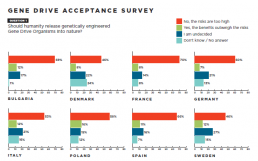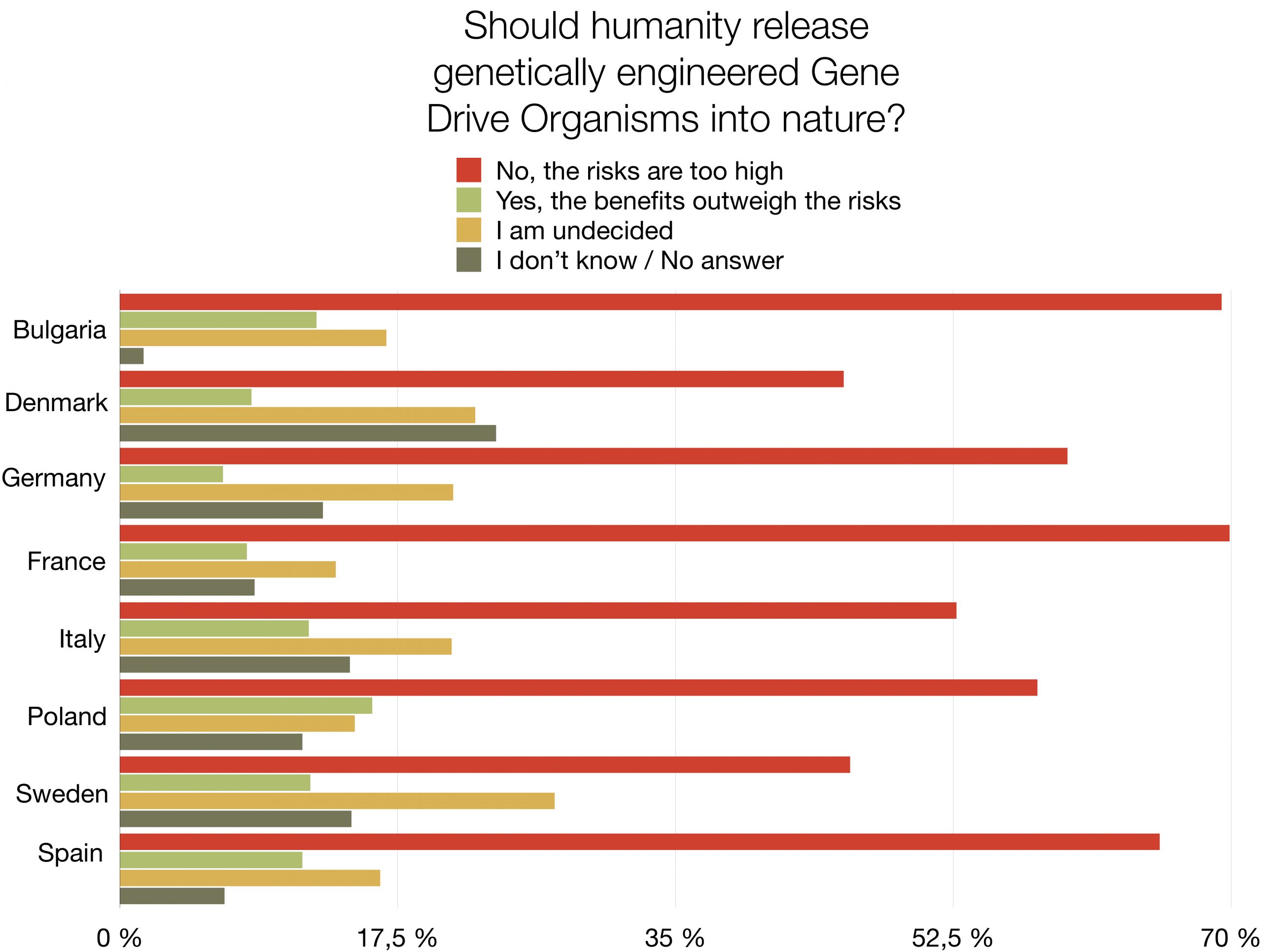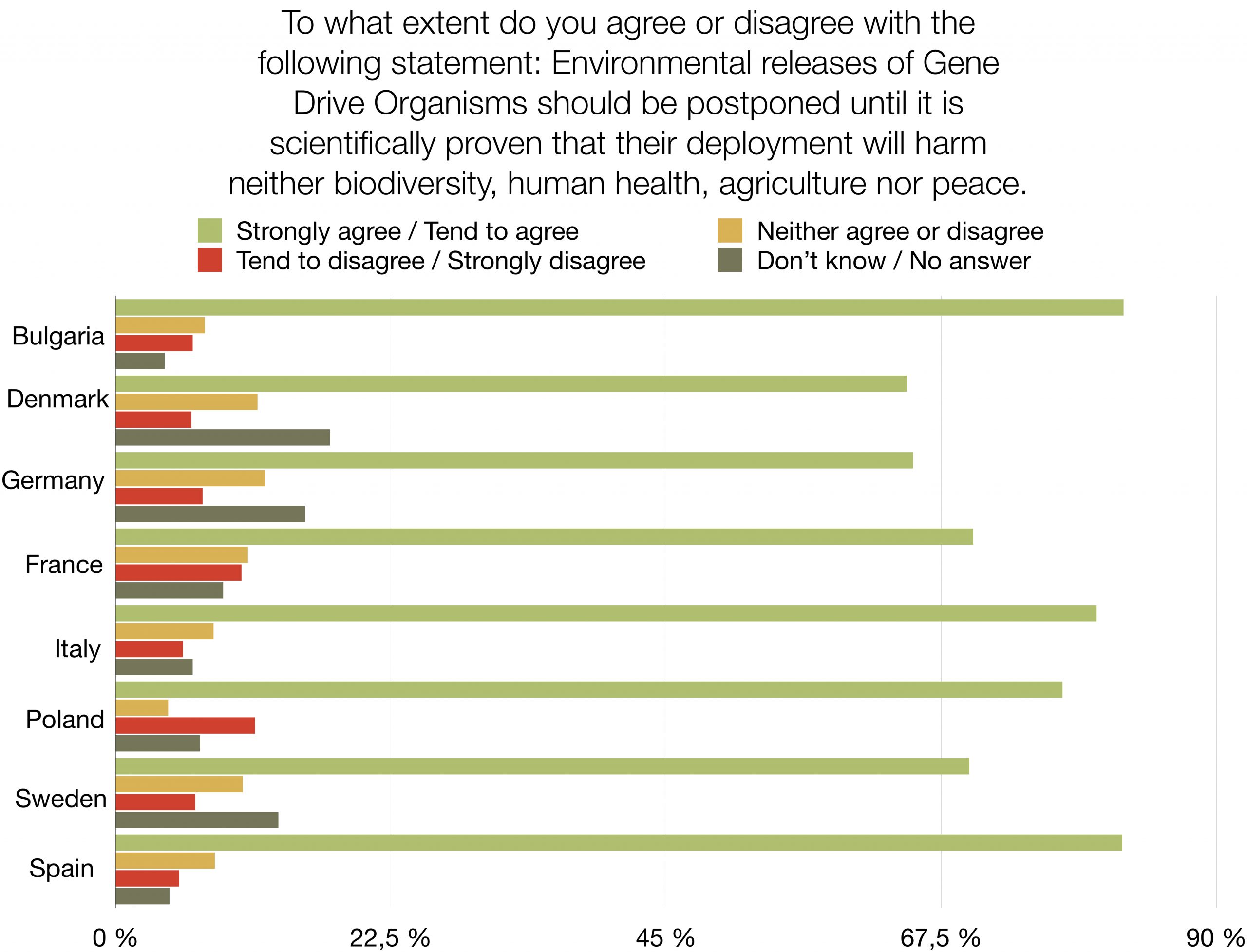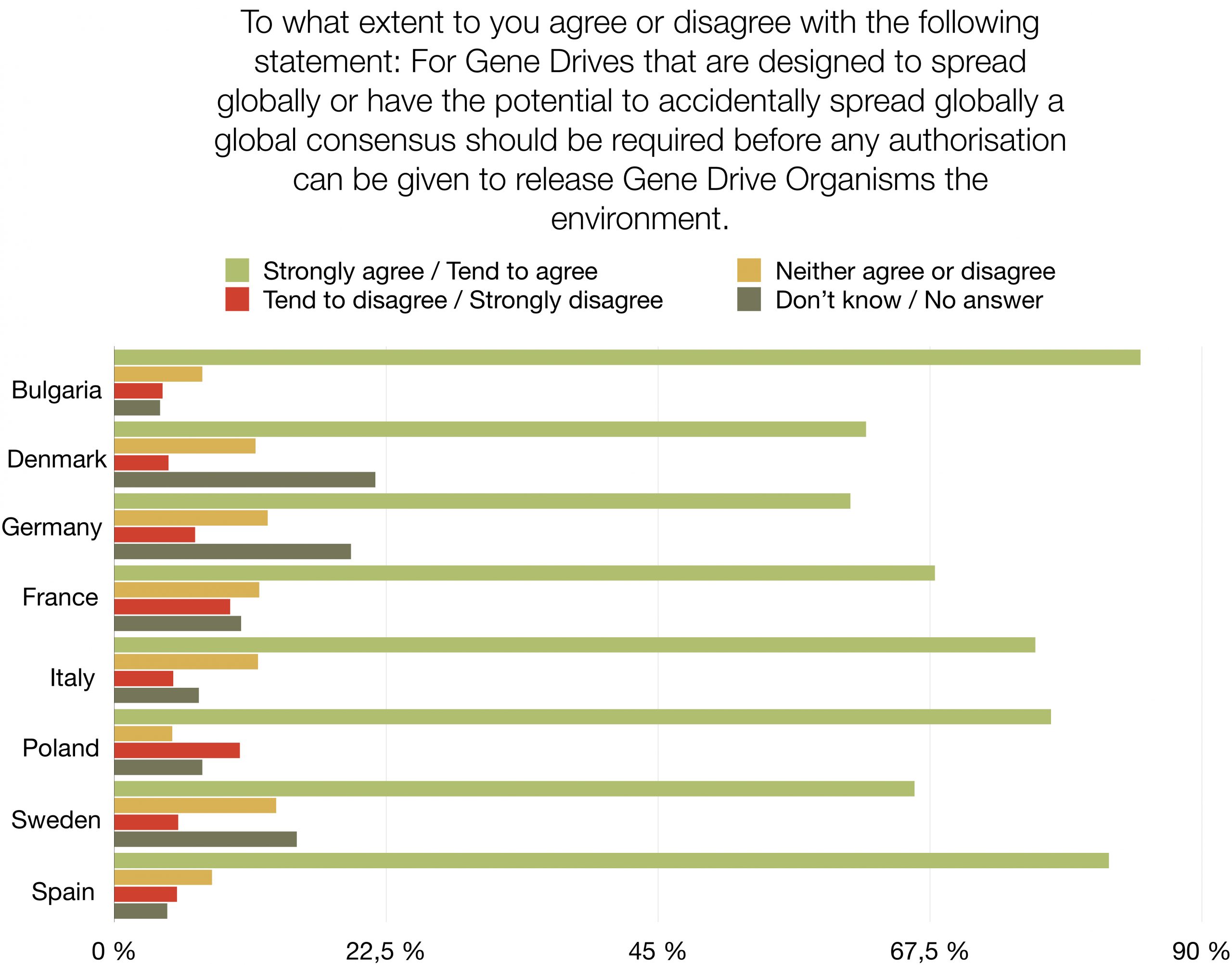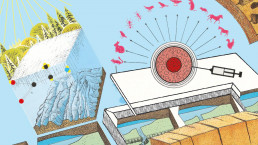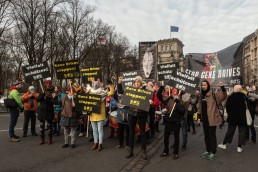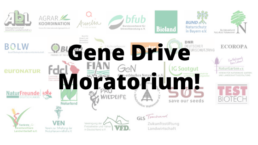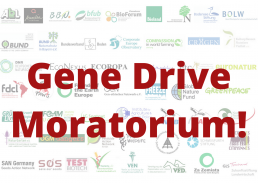Survey: EU citizens reject genetic engineering of wild species with Gene Drives
27. Januar 2021Neuigkeiten,Startseite
Should humanity release genetically engineered gene drive organisms into nature? The response of a majority of citizens in eight European countries is: “No, the risks are too high”. This first opinion poll on the subject shows high levels of rejection (46% - 70%) and very low levels of support (7% - 16%) for the use of Gene Drive technology in the environment. The survey amongst nearly 9.000 people is representative of 280 million EU citizens. It was commissioned by nine NGOs demanding an informed and inclusive public debate and a global moratorium on the environmental release of this new type of genetically modified organisms. The survey also reveals that a large proportion of respondents is still undecided (14% - 27%) or did not know how to answer (1% - 24%).
"Such a powerful technology with potentially irreversible consequences for wild species and all their ecosystems must be controlled by strict international rules and procedures of decision making. We do not believe that the release of gene drive organisms from the lab into the environment should happen at all. At least, it would require strict international standards of risk and technology assessment and a prior inclusive, democratic decision making based on precaution and the prior informed consent of all peoples and states potentially affected" states Mareike Imken from Save Our Seeds, Germany, who coordinates the European Stop Gene Drive campaign."
A large majority of respondents (65%-82%) agree that environmental releases of gene drive organisms should be postponed until there is scientific proof that their release would not harm biodiversity, human health, agriculture or peace. A similar majority (61% - 85%) agrees that the authorisation of environmental releases of gene drive organisms that could spread globally should require a global consensus.
This representative survey was conducted by the international market research institute YouGov and polled 8.826 citizens, from 8 EU countries, including Germany, Italy, France, Spain, Poland, Denmark, Sweden and Bulgaria in December 2020. It was commissioned by WeMove Europe, Save Our Seeds (Germany), Skiftet (Sweden), France Nature Environnement (FNE) (France), POLLINIS (France), OGM Dangers (France), Bund für Umwelt und Naturschutz (BUND) (Germany), Deutscher Naturschutzring (DNR) (Germany), Umweltinstitut München (Germany), Za Zemiata (Bulgaria).
Downloads
Download YouGov Results Gene-Drive Opinion Poll | PDF
Download Gene Drive Acceptance Survey - A graphic overview of the results | PDF
Further information
EU-wide petition for global gene drive moratorium
Open letter by over 200 organizations worldwide calling for global gene drive moratorium
Resolution of the European Parliament for a global gene drive moratorium
Online-Discussion: Gene Drives - Protecting People and Nature through Genetic Extermination?
11. November 2020Neuigkeiten,Startseite
Ricarda Steinbrecher, geneticist and board member of the European Network for Scientists for Social and Environmental Responsibility (ENSSER), emphasized that it is difficult or even impossible to make reliable predictions about the effects of a future application of Gene Drives, especially at the current time. After all, organisms are released which then independently carry out the genetic modifications in each generation. "Mistakes can be made every time. Every time, something else can be added." To ensure the preservation of biodiversity, new technologies such as Gene Drives must be looked at very closely to ensure that they do not pose any risks to our ecosystems. This is why she strongly advocated the precautionary principle during the international negotiations on the regulation of gene drive technology at the UN Convention on Biological Diversity. As a long-standing scientific advisor and participant in expert groups within the UN Convention on Biological Diversity, she reported that there is a strong influence of lobby groups on these expert bodies: For example, the Bill & Melinda Gates Foundation, one of the main financiers of the technology, had invested 1.6 million dollars in a PR agency to increase the acceptance of Gene Drives. She concluded: "The pressure to implement this technology is not commensurate with the risk."
Ali Tapsoba de Goamma, human rights and environmental activist from Burkina Faso and spokesperson for a civil society association of 40 organizations for agroecology and against Gene Drives (CCAE), reported that since 2012, the project Target Malaria has been preparing to decimate malaria-transmitting mosquitoes in Burkina Faso by means of Gene Drives. In 2019, the first field tests with genetically modified male mosquitoes that are not capable of reproducing took place, but not any Gene Drive Organisms have been released yet. Ali Tapsoba de Goamma criticized that Target Malaria had obtained the consent of the government and village leaders for these tests, but not the consent of the entire population of Burkina Faso. Rather, they had taken advantage of the fact that there are so many illiterate people in the local villages. The majority of the inhabitants of Burkina Faso are against these experiments. He raised the question: "Why not try this first in scientifically better equipped countries, but in Burkina Faso?" In his view, Burkina Faso was in a position to combat malaria itself. He said that this does not require gene drives, but a good health concept.
Dr. Andreas Wulf, doctor and consultant for global health at the medical emergency aid organization Medico International, emphasized that epidemics like malaria require long-term strategies. The idea of trying to solve such a disease with the one-time use of a technology without continued commitment is questionable, he said. One should not rely on such a "technological fix". Experience in combating other epidemics has shown that the success of the measures depends on good cooperation with the people on the ground and finding local solutions. He also criticized from a democratic point of view: "It is a problem that so much decision-making power is given to these private actors, the companies / foundations. A handful of people choose which area of research to invest in. In addition, the media coverage of research is also financially supported by these foundations". Dr. Andreas Wulf concluded that these private funds need to be embedded in the public health systems.
Mareike Imken, head of the Stop Gene Drive campaign of Save Our Seeds, explained that with the European campaign, which is supported by many organizations throughout Europe, she wanted to initiate a critical discussion in society and politics about "whether and if so, under what circumstances we want to use this technology and what restrictions it needs."
She went on to explain: "Gene Drives provides us as humanity with a tool to specifically eradicate or change wild species. In times of a species extinction that is existential for mankind, this must be considered and ethically discussed. This should not be decided lightly by those few people". She also points out that "the knowledge about Gene Drives is not yet sufficiently advanced".
In order to have time for this discussion, in-depth risk research including technology assessment and the development of internationally valid rules and decision-making mechanisms, a global moratorium on the release of gene drive organisms is needed. This moratorium must be adopted at the next Conference of the Parties of the UN Convention on Biological Diversity (COP 15).
Online-Veranstaltung zu Gene Drives: Mit gentechnischer Ausrottung Menschen und Natur schützen?
15. Oktober 2020Startseite,Neuigkeiten
Ricarda Steinbrecher, Genetikerin und Vorstandsmitglied des European Networks for Scientists for Social and Environmental Responsibility (ENSSER) betonte, dass es – vor allem zum aktuellen Zeitpunkt – schwer bis unmöglich sei, verlässliche Vorhersagen über die Auswirkungen einer zukünftigen Anwendung von Gene Drives zu machen. Schließlich setze man Organismen frei, die dann selbstständig in der Natur die gentechnischen Veränderungen in jeder Generation von Neuem vornähmen. „Jedes Mal können Fehler eingebaut werden. Jedes Mal kann etwas Anderes noch dazu kommen.“ Um den Erhalt der Biodiversität zu gewährleisten, müsse man sich neue Technologien wie Gene Drives sehr genau anschauen, um sicherzustellen, dass von ihnen keine Risiken für die Ökosysteme ausgingen. Deshalb setzte sie sich bei den internationalen Verhandlungen um die Regulierung der Gene Drive Technologie bei der UN Biodiversitätskonvention stark für das Vorsorgeprinzip ein. Als langjährige wissenschaftliche Beraterin und Teilnehmerin von Expertengruppen innerhalb der UN Biodiversitätskonvention berichtete sie, dass es eine starke Einflussnahme von Lobbygruppen auf diese Expertengremien gebe: So habe die Bill & Melinda Gates Stiftung, einer der Hauptfinanziers der Technologie, 1,6 Millionen. Dollar in eine PR-Agentur gesteckt, um die Akzeptanz von Gene Drives zu erhöhen. Sie schlussfolgerte: „Der Druck das umzusetzen ist nicht angemessen, gegenüber dem Risiko.“
Ali Tapsoba de Goamma, Menschenrechts- und Umweltaktivist aus Burkina Faso und Sprecher eines 40 Organisationen umfassenden zivilgesellschaftlichen Zusammenschlusses für Agrarökologie und gegen Gene Drives (CCAE) berichtete, dass in Burkina Faso seit 2012 das Projekt Target Malaria Faso Vorbereitungen treffe, um mittels Gene Drives malariaübertragende Mücken zu dezimieren. Im Jahr 2019 hätten erste Freiland-Tests mit gentechnisch veränderten, nicht fortpflanzungsfähigen männlichen Mücken stattgefunden, die jedoch noch keinen Gene Drive in sich getragen hätten. Ali Tapsoba de Goamma kritisierte, dass Target Malaria sich für diese Tests zwar das Einverständnis der Regierung und der Dorfvorsteher, nicht aber die Zustimmung der gesamten Bevölkerung von Burkina Faso eingeholt habe. Vielmehr hätten sie es sich zu Nutzen gemacht, dass es in den lokalen Dörfern so viele Analphabeten gebe. Die Mehrheit der Menschen in Burkina Faso sei gegen diese Experimente. Er warf die Frage auf: „Warum probiert man das nicht erst in wissenschaftlich besser ausgestatteten Ländern, sondern in Burkina Faso?“ Aus seiner Sicht sei Burkina Faso in der Lage, die Malaria selbst zu bekämpfen. Dafür brauche es keine Gene Drives, sondern ein gutes Gesundheitskonzept.
Dr. Andreas Wulf, Arzt und Referent für globale Gesundheit bei der medizinischen Nothilfeorganisation Medico International betonte, dass es bei Epidemien wie Malaria auf langfristige Strategien ankäme. Die Idee, eine solche Krankheit mit dem einmaligen Einsatz einer Technologie ohne fortgeführtes Engagement lösen zu wollen, sei bedenklich. Man dürfe sich nicht auf einen solchen „technologischen Fix“ verlassen. Im Gegenteil habe die Erfahrung bei der Bekämpfung anderer Epidemien gezeigt, dass es für den Erfolg der Maßnahmen darauf ankomme, gut mit den Menschen vor Ort zusammenzuarbeiten und lokale Lösungen zu finden. Darüber hinaus kritisierte er aus demokratischer Sicht: „Es ist ein Problem, dass diesen privaten Akteuren, den Unternehmen / Stiftungen so viel Entscheidungsmacht zugesprochen wird. Eine Handvoll Menschen entscheiden, in welchen Bereich der Forschung investiert wird. Zudem wird auch die mediale Berichterstattung zur Forschung von diesen Stiftungen finanziell begleitet.“ Es brauche eine Einbettung dieser privaten Gelder in die öffentlichen Gesundheitssysteme schlussfolgerte Dr. Andreas Wulf.
Mareike Imken, Leiterin der Stop Gene Drive Kampagne von Save Our Seeds legte dar, dass sie mit der europäischen Kampagne, welche von vielen Organisationen europaweit unterstützt werde, eine kritische Diskussion in Gesellschaft und Politik darüber anstoßen wolle, „ob und wenn ja, unter welchen Umständen wir diese Technologie nutzen wollen und welche Einschränkungen sie braucht.“
Sie erklärte weiter: „Mit Gene Drives bekommen wir als Menschheit ein Werkzeug an die Hand, um wildlebende Arten gezielt auszurotten oder zu verändern. In Zeiten eines für die Menschheit existenziellen Artensterbens ist dies zu bedenken und ethisch zu diskutieren. Das sollte nicht leichtfertig von wenigen entschieden werden.“ Auch stellt sie heraus, dass "das Wissen zu Gene Drives noch nicht weit genug fortgeschritten“ ist.
Um Zeit für diese Diskussion, vertiefte Risikoforschung incl. Technikfolgenabschätzung und die Entwicklung international gültiger Regeln und Entscheidungsmechanismen zu haben, brauche es ein globales Moratorium auf die Freisetzung von Gene Drive Organismen. Dieses müsse bei der nächsten Vertragsstaatenkonferenz der UN Biodiversitätskonvention (COP 15) beschlossen werden, um erste Freisetzungsversuche aufzuschieben und abzusichern.
78 Verbände fordern EU Kommission zum Stopp der Gene Drive Risikotechnologie auf
30. Juni 2020Startseite,Neuigkeiten
In einem offenen Brief rufen 78 Umwelt-, Agrar-, Tierschutz- und Entwicklungsorganisationen aus ganz Europa die EU-Kommission dazu auf, die Freisetzung sogenannter Gene Drive Organismen in der EU und international zu ächten.
Die unterzeichnenden Organisationen, unter ihnen der Deutsche Naturschutzring (DNR), der Bund für Umwelt und Naturschutz Deutschland (BUND), Save Our Seeds und die Aurelia Stiftung fordern von der EU, sich auf der nächsten Vertragsstaatenkonferenz (COP 15) der UN-Biodiversitätskonvention für ein globales Moratorium auf die Freisetzung von Gene Drive Organismen einzusetzen. Dasselbe verlangt auch das Europäische Parlament in einem Entschließungsantrag vom Januar dieses Jahres und ist damit einem Aufruf von über 200 Unterzeichner*innen aus Europa und weltweit gefolgt.
„Gene Drives sind ein immenses Risiko für Ökosysteme“, so die unterzeichnenden Verbände einstimmig. "Die EU muss sich für ein globales Moratorium einsetzen und gleichzeitig mit gutem Beispiel vorangehen. Dieser Risikotechnologie muss ein Riegel vorgeschoben werden.“
Mithilfe des Gentechnikverfahrens CRISPR/CAS9 werden im Labor Mücken, Mäuse, Fruchtfliegen und andere Organismen erzeugt, die eine bestimmte Eigenschaft mitsamt dem Mechanismus zur gentechnischen Manipulation künftiger Generationen an sämtliche Nachkommen vererben. So können Gene Drive Organismen ihre Artgenossen in der Natur ersetzen. Die Gene Drive Eigenschaft setzt sich auch dann durch, wenn sie für das Überleben der Art tödlich ist. Eingesetzt werden soll die Technologie zur Bekämpfung sogenannter Agrarschädlinge, invasiver Arten und krankheitsübertragender Insekten.
Thomas Radetzki, Vorstandsvorsitzender der mitunterzeichnenden Aurelia Stiftung kommentiert: „Die Vielfalt der Arten, auch der Bienen und ihrer Lebensräume, ist in existenzieller Weise bedroht. Die Gene Drive Technologie könnte massiv in diese bereits geschädigten Ökosysteme eingreifen. Ihre Risiken sind offenkundig. Die Anwendung der Technologie widerspricht daher dem Vorsorgeprinzip, das sowohl in der EU als auch international die Grundlage für das Naturschutzrecht bildet.“
Mit Blick auf die Risiken für eine intakte Umwelt und die menschliche Gesundheit erklärt Mareike Imken von Save Our Seeds und Initiatorin der europäischen Kampagne „Stop Gene Drives“: „Die von Gene Drive Organismen ausgehenden Umwelt- und Gesundheitsrisiken sind nicht ansatzweise erforscht. Eine Vorhersage, Eingrenzung oder Umkehrung ihrer Effekte in der Natur sind unmöglich. Deshalb ist bereits ihre Erforschung riskant: schon wenige Gene Drive Organismen, die aus dem Labor entkommen, können eine unkontrollierbare gentechnische Kettenreaktion in der Natur auslösen. Ein Moratorium gibt uns die Zeit, offene Fragen zu klären und fehlende Regularien und Entscheidungsmechanismen zu etablieren. Vorher sollte niemand auf der Welt diese Risikotechnologie nutzen.“
„Der Verlust an Biodiversität ist eine der größten Herausforderungen unserer Zeit. Es ist daher unverantwortlich, Arten und Ökosysteme weiteren Risiken auszusetzen. Eine Freisetzung von Gene Drive Organismen in die Natur ist mit enormen Risiken verbunden und erfordert eine viel umfangreichere Technikfolgenabschätzung, Risikobewertung und Überwachung, als das in Europa und in vielen anderen Ländern aktuell gesetzlich vorgeschrieben wird. Da eine grenzüberschreitende, effektive Kontrolle der Ausbreitung von Gene Drive Organismen nicht möglich ist, gibt es nur eine Möglichkeit: ein weltweites Moratorium“, erläutert Undine Kurth, Vizepräsidentin des Deutschen Naturschutzrings als Mitunterzeichnerin des Briefes.
„Auch Gene Drives werden das Problem von invasiven Arten nicht lösen können - im Gegenteil haben sie das Potential, neue invasive Arten mit unbekannten Eigenschaften zu schaffen“, erklärt Antje von Broock, Geschäftsführerin für Politik und Kommunikation beim Bund für Umwelt und Naturschutz Deutschland (BUND): „Mit der kürzlich durch die EU-Kommission vorgestellten EU-Biodiversitätsstrategie will die EU eine globale Vorreiterrolle zum Schutz der Biodiversität einnehmen und dem Artensterben ein Ende setzen. Wir sagen nein zu Gedankenspielen, mit Gene Drives die gezielte Ausrottung von Arten unter dem Deckmantel des Naturschutzes zu betreiben.“
Abschließend fordern alle Verbandsvertreter*innen die EU dazu auf, zum Schutz von Mensch und Umwelt zu handeln: „Die EU-Kommission und die deutsche Bundesregierung in ihrer Rolle als Vorsitzende des EU-Rats sollten dem Ruf des Europaparlaments folgen und ein vorläufiges Freisetzungsverbot von Gene Drive Organismen auf die internationale Agenda setzen.“
Die gemeinsame Pressemitteilung von BUND, DNR, SOS und der Aurelia Stiftung finden Sie hier:
Hintergrund:
Zum offenen Verbändebrief an die EU Kommission.
Verbändebrief an Europaparlamentarier*innen vom Januar 2020.
78 organizations call on the European Commission to enact a temporary ban on the novel Gene Drive technology
29. Juni 2020Neuigkeiten,Startseite
Gene Drive technology: Species extinction through genetic engineering?
In an open letter initiated by Greenpeace EU, Friends of the Earth Europe, IFOAM EU and the German initiative Save Our Seeds, 78 environmental, agricultural, animal welfare and development aid organizsations from all over Europe are calling on the EU Commission to outlaw the release of so-called Gene Drive Organisms in the EU and internationally. With this new application of genetic engineering, entire animal populations and species in nature could be reprogrammed or eradicated.
Enabled by the genetic engineering method CRISPR/CAS9, mosquitoes, mice, fruit flies and other organisms can be manipulated in the laboratory to pass on a certain trait and the mechanism for genetic manipulation to all offspring and across generations. In this way, Gene Drive Organisms can replace their relatives in nature. The Gene Drive trait also asserts itself when it is deadly to the survival of the species – thereby ovveriding the normal rules of evolutionary selection.
The signatory organisations are calling on the EU to advocate a global moratorium on the release of Gene Drive Organisms at the next Conference of the Parties (COP 15) to the UN Convention on Biological Diversity (CBD). The European Parliament had already called for such a moratoirum in a resolution from January this year, responding to a call from over 200 signatories from Europe and worldwide.
"The loss of biodiversity is one of the greatest challenges of our time. While the risks of Gene Drive technology have not yet been scientifically assessed, it could have a massive impact on already damaged ecosystems. It is irresponsible to expose species and ecosystems to further risks“ explains the initiator of the European "Stop Gene Drives" campaign, Mareike Imken from the German initiative Save Our Seeds.
She adds: „The EU Commission recently presented its biodiversity strategy, with which it wants to make the EU a global pioneer for the protection of biodiversity and put an end to the ongoing mass extinction of species. The Gene Drive technology however is designed to drive wild populations and species into self destruction. The use of such a technology contradicts the aim of biodiversity conservation and the precautionary principle, which is the basis for international and EU nature conservation law. A global moratorium would give us the time to assess environmental and health risks, publicly evaluate and discuss this technology and to establish missing regulations and global decision-making mechanisms. In the meanwhile, noone in the world should use this technology."
The open letter signed by 78 organizations can be found here.
Further reading:
Further information on gene drives:
www.stop-genedrives.eu/en
29 German Organizations call for a Global Gene Drive Moratorium
In a joint open letter sent to the German federal ministers Karliczek, Klöckner and Schulze on February 19, 2020, an alliance of 29 German organizations called on the German government to support a global gene drive moratorium in the upcoming international negotiations.
The reason for the joint letter were important EU and international decisions with regard to the gene drive technology:
At the Conference of the Parties to the UN Convention on Biological Diversity planned for October 2020 in China, the German federal government could play an important role within the scope of its EU Council Presidency. Furthermore, the German government would be able to already set the course for the regulation of this technology at the expert conferences taking place in advance of the convention, especially at SBSTTA 24 planned for June 2020 [postponed to May 2021 due to COVID].
In addition, as part of Germanys membership in World Conservation Union (IUCN), the German government could input to a consultation process on draft resolution 075 on the role of synthetic biology (including gene drives) for the protection of biodiversity within the IUCN, ahead of World Congress planned for May 2020 [postponed to September 2021). This resolution is meant to provide the basis for an inclusive discussion process within IUCN. Its members are invited to exchange views on the potential role of applications of synthetic biology, including gene drives, for the conservation of biodiversity. At the IUCN World Congress 2024, the world conservation organization will vote on its official position on this issue.
In its letter, the alliance calls on the German federal government to follow the European Parliament's vote of January 16, 2020, at the CBD COP 15, in which the European Parliament petitioned the EU to motion for a resolution calling for a global moratorium on the release of gene drive organisms into nature at the next Conference of the Parties to the UN Convention on Biological Diversity in order to prevent premature experiments with the technology in nature.
19. Februar 2020
29 deutsche Organisationen für globales Gene Drive Moratorium
In einem gemeinsamen offenen Brief, der am 19.02.2020 an die Ministerinnen Karliczek, Klöckner und Schulze versendet wurde, forderte ein Bündnis aus 29 deutschen Organisationen die Bundesregierung dazu auf, sich bei anstehenden internationalen Verhandlungen für ein globales Gene Drive Moratorium auszusprechen.
Anlass für den gemeinsamen Brief war, dass in Bezug auf die Gene Drive Technologie in den nächsten Monaten wichtige Entscheidungen anstehen: Bei der im Oktober stattfinden Vertragsstaatenkonferenz der UN-Biodiversitätskonvention in China wird die Bundesregierung im Rahmen Ihrer EU-Ratspräsidentschaft eine wichtige Rolle spielen. Auch bereits bei den vorab stattfindenden Expert*innenkonferenzen, darunter vor allem der SBSTTA 24 im Mai, kann die Bundesregierung entscheidende Weichen für die Regulierung dieser Technologie stellen. Zusätzlich findet derzeit innerhalb der Weltnaturschutzorganisation IUCN ein Konsultationsprozess statt, in dem alle IUCN-Mitglieder, darunter Deutschland, aufgefordert sind, bezüglich des Resolutionsentwurfs 075 zur Rolle der synthetischen Biologie (einschließlich Gene Drives) für den Schutz der Artenvielfalt Kommentare beizusteuern. Diese Resolution soll die Grundlage für einen inklusiven Diskussionsprozess innerhalb der IUCN bieten, in dem sich deren Mitglieder über die mögliche Rolle von Anwendungen der synthetischen Biologie, darunter Gene Drives für den Schutz der Artenvielfalt austauschen sollen. Beim IUCN Weltkongress 2024 will die Weltnaturschutzorganisation dann seine offizielle Position dazu abstimmen.
Das Bündnis fordert die Bundesregierung in ihrem Brief dazu auf, dem Votum des Europäischen Parlaments vom 16. Januar 2020 zur CBD COP 15 zu folgen, in dem das Europäische Parlament die EU in einem Entschließungsantrag dazu aufforderte, zum Schutz der weltweiten Artenvielfalt bei der nächsten Vertragsstaatenkonferenz der UN-Biodiversitätskonvention einen globalen Freisetzungsstopp (moratorium) für Gene Drive Organismen in die Natur zu fordern, um verfrühten Experimenten mit der Technologie in der Natur vorzubeugen.
19. Februar 2020
Europaparlament fordert globales Gene Drive Moratorium!
Bei seiner Plenarsitzung am 16.01.2020 hat das Europäische Parlament seine Position für die 15. Vertragsstaatenkonferenz der UN-Biodiversitäts- konvention (COP 15 CBD) festgelegt. In ihrer Resolution fordern die Europa- parlamentarier*innen die EU dazu auf, sich bei den im Oktober anstehenden internationalen Verhandlungen der CBD für ein globales Gene Drive-Moratorium einzusetzen.
Mit einem gemeinsamen Brief hatte ein EU-weites Bündnis von über 50 NGOs, darunter Greenpeace, Friends of the Earth Europe und IFOAM EU, die Abgeordneten im Vorfeld dazu aufgerufen, für entsprechende Änderungsanträge zu stimmen.
Die nächste Vertragsstaatenkonferenz der CBD im Oktober 2020 in China könnte einer der letzten Momente sein, um geplante Freisetzungen von Gene Drive Mücken durch das Projekt Target Malaria zu unterbinden. Eine Freisetzung von Gene Drive Organismen würde eine unkontrollierbare Ausbreitung der auf neuartige weise gentechnisch veränderten Organismen verursachen – und eine globale Ausbreitung und unwiderrufliche Veränderung oder Schädigung von Ökosystemen zur Folge haben. Da es bis dato keine Möglichkeit gibt, einmal freigesetzte Gene Drive Organismen wieder aus der Natur zu entfernen oder Veränderungen und Schäden in Ökosystemen, Nahrungsnetzen und an der Artenvielfalt rückgängig zu machen, widerspricht eine solche Freisetzung dem Vorsorgeprinzip. Dieses wurde eigens von der CBD zum Schutz der Artenvielfalt geschaffen und ist die Grundlage des europäischen als auch deutschen Naturschutzrechts.
Save Our Seeds hatte sich im Jahr 2019 für die Einbringung dieser Änderungsanträge im Europaparlament stark gemacht und unterstützte als Teil eines starken Bündnisses aus deutschen NGOs, Stiftungen und Expert*innen die Forderungen des Briefes und die Unterstützung von nun angenommen Änderungsanträgen, die zum Ziel hatten:
- eine Freisetzung von Gene Drive Organismen in die Natur zu unterbinden
- die Anwendung und rechtliche Stärkung des Vorsorgeprinzips im der neu zu schaffenden UN-Rahmenkonvention für die Artenvielfalt nach 2020 unterstützen
- eine vorbeugende Technikfolgenabschätzung, technologische Vorausschau (Horizon Scanning) und Überwachung (Monitoring) für neue Technologien wie Gene Drives vorzuschreiben
- die Wahrung von Rechten auf eine informierte vorherige Zustimmung lokaler Gemeinschaften und indigener Völker vor einem Einsatz risikoreicher Technologien in ihrer Umwelt zu gewährleisten
Links
- Resolution des Europäischen Parlaments
- Verbändebrief an Europaparlamentarier*innen
- Gene Drive Briefing für EU-Parlamentarier*innen auf Englisch
- Zusammenfassung des Gene Drive Berichts von ENSSER, VDW und CSS auf Englisch
European Parliament calls for a Global Gene Drive Moratorium
At its plenary session on January 16, 2020, the European Parliament defined its position for the 15th Conference of the Parties to the UN Biodiversity Convention (COP 15 CBD). In their resolution, MEPs call on the EU to support a global moratorium on gene drives in the international negotiations of the CBD. In a joint letter, an EU-wide alliance of more than 50 NGOs, including Greenpeace, Friends of the Earth Europe and IFOAM EU, had previously called on MEPs to vote for such amendments.
The next Conference of the Parties (COP 15) to the CBD in China could be one of the last moments to stop planned releases of gene drive mosquitoes by the Target Malaria project. A release of gene drive organisms would cause an uncontrollable spread of the genetically modified organisms in an unprecedented manner - and result in a global spread and irreversible change or damage to ecosystems. Once released, there is currently no way to remove gene drive organisms from the wild or to reverse changes and damage to ecosystems, food webs and biodiversity. Hence, such a release is contrary to the precautionary principle. This principle was created by the CBD specifically to protect biodiversity and forms the basis of both European and German nature conservation law.
- Resolution of the European parliament (see paragraph 13)
- Civil Society Letter to the Members of the European Parliament
- Gene Drive Briefing für EU-Parlamentarier*innen auf Englisch
- Summary of the scientific Gene Drive Report by ENSSER, VDW und CSS
Gene drives regulated for the first time in genetic engineering law
On June 7, 2019, the Federal Council spoke out in favour of tightening the safety requirements for laboratory experiments with gene drive organisms (GDO) in the Genetic Engineering Safety Ordinance. In addition, it also demands the development of GDO-specific safety measures and calls on the German government to give special weight to nature conservation.
Mosquitoes, flies and mice, but also plants can be modified by a new genetic engineering method called gene drive in such a way that they quickly and comprehensively spread a new trait and in wild populations. Through a special application of the so-called CRISPR-Cas technology, the genetic manipulation itself can be passed on and thus trigger a genetic chain reaction in nature that cannot be controlled in time or space. By releasing such gene drive organisms, entire populations or species in nature are to be genetically modified or even eradicated. Experiments with gene drive organisms in the laboratory involve the risk of experimental animals escaping. Even a few released GDOs could theoretically lead to the extinction of a species in nature.
After an alliance of NGOs (the AbL, BUND, GeN, IG-Saatgut, Testbiotech and Save Our Seeds) drew attention to this danger in an open letter, the federal states responsible for genetic engineering safety became active. At the plenary session of the Federal Council on June 7, 2019, the federal states responsible for the supervision of genetic engineering decided to set a safety level 3 (out of a possible four; the second more serious risk classification) for laboratory experiments with gene drive organisms for precautionary reasons. In an amendment to the Genetic Engineering Safety Ordinance, the federal government included GDOs in the ordinance for the first time and only provided for safety level 2 for laboratory experiments. In addition to this amendment, the federal states appealed to the federal government "to give special weight to the objects of protection under § 1 No. 1 of the Gene Technology Act and in particular to nature conservation in the future design of the specifications for the risk assessment and safety classification of gene drive organisms, over and above the regulations on gene drive organisms laid down in the Ordinance for the Reorganisation of the Law on Safety Levels and Safety Measures for Gene Technology Work in Gene Technology Facilities, taking into account the precautionary principle".
Following the Federal Council’s decision, the Genetic Engineering Safety Ordinance has become operative and includes gene drive organisms in the regulation of genetic engineering law for the first time.
However, there is also a catch: after the automatic classification of gene drive organisms in safety level 3, the Central Commission carries out a case-by-case assessment for Biological Safety (ZKBS). Based on this assessment, the ZKBS can select a different safety level, including safety level 1, which assumes that the risk to the environment and human health posed by the explored GMOs is negligible and therefore does not require any special safety requirements.
For this reason, the Federal Council's welcome decision was only the first, urgently required step. Since the Genetic Engineering Safety Ordinance is not yet designed to cover the risks posed by genetically modified organisms to biodiversity and the environment, the ZKBS and the federal states should draw up specific safety measures for this new class of genetically modified organisms as quickly as possible. In addition, the expert position on nature conservation issues within the ZKBS, which has been vacant for years, must now be filled quickly. We can no longer continue to perform safety classification and risk assessment of gene drive organisms without giving special weight to nature conservation.

